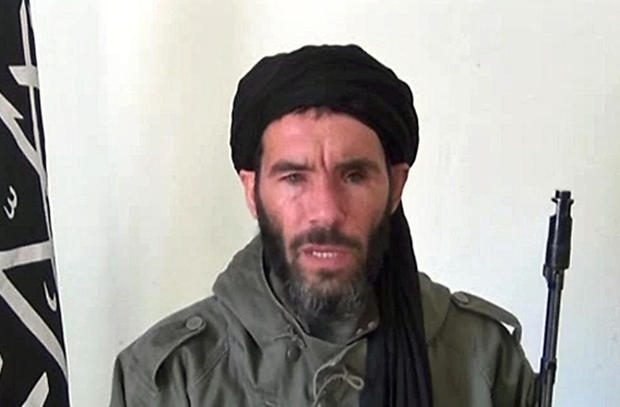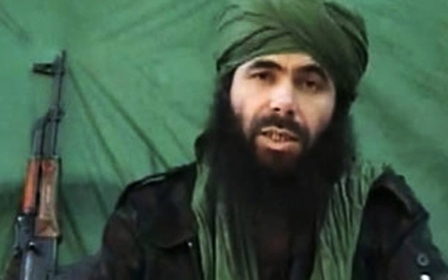Belmokhtar's killing would be major blow for AQIM

The killing of Algerian national Mokhtar Belmokhtar, announced by the Libyan government but so far denied by the jihadist leader’s relatives, could significantly undermine AQIM.
“If his death is confirmed, it would clearly weaken al-Qaeda in Islamic Maghreb (AQIM) which will struggle to replace such a good warlord,” said Mauritanian journalist Lemine Ould M Salem, author of a biography on the jihadist leader (Mokhtar Belmokhtar, the Bin Laden of the Sahara).
Although the Tobruk-based Libyan government, recognised by the international community, announced in a statement that Mokhtar Belmokhtar had been killed in a US airstrike on Saturday night, the death of the mastermind behind the Tiguentourine hostage-taking operations is so far not confirmed by the Pentagon.
Salem finds his disappearance hard to believe since it contradicts with the list of killed fighters published by the Adjabiya Revolutionaries Coalition, an alliance of Libyan armed Islamist militias.
Even if the leader of the Blood Signatories, a dissident movement founded by Belmokhtar in December 2012 during the war in Mali, is aware of being spotted, “for the time being, he better stay in this heavily populated region of Libya where he can hide more easily than in the desert, and where his friends of Ansar Sharia can protect him,” Salem told Middle East Eye. “The other area where he could also retreat is Mount Chaâmbi, in southern Tunisia, still largely controlled by AQIM through the Tariq Ibn Ziyad katiba [combat unit].”
Algerian concerns
Algerian intelligence services strongly believe in a scenario similar to that of Tunisia, considered the weak link of the Maghreb countries, destabilised by events unfolding in Libya. Worse still, three Tunisian gendarmes were killed on Tuesday 15 June in the region of Sidi Bouzid. Jihadists affiliated to the Islamic State group (Daesh) claimed responsibility for the attack.
“We are very concerned by the progress of groups that claim to be affiliated to IS in Libya,” an Algerian intelligence services official admitted to Middle East Eye. “In particular, the connections they could establish with the jihadists in the Sahel. We do not exclude any scenario: that of Libya controlled 80 percent by IS that would destabilise Tunisia, or even of organised attacks from bordering countries against our oil bases in Ouargla or Illizi, just like the hostage-taking on the Tiguentourine base in January 2013, that was the result of a raid launched from the north of Mali and Libya.”
The south-east of Algeria, considered a nerve centre due to the presence of its oil fields, is so vast and sparsely populated that it constitutes a soft underbelly that would allow infiltration by armed groups, especially with the deteriorating situation in Libya.
After the takeover of the Libyan city of Sirte by Islamic State fighters on 29 May, Algeria has also decided to upgrade its border security apparatus by deploying a reinforcement of tens of thousands of men. Now it has almost 100,000 troops stretched across the 4,500 km-long border with Tunisia, Libya, Niger and Mali. That figure constitutes a third of the army’s contingents.
“We are also concerned by the possibility that a second front from Nigeria to the Sahel might emerge,” said the officer, referring to a message released in March by Abu Mohammed al-Adnani, deputy of Abu Bakr al-Baghdadi, the self-proclaimed leader of the Islamic State, calling on all those who could not reach Syria and Iraq to join the combat in Nigeria.
Is AQIM weakened?
Is this scenario realistic? Jean-Paul Rouiller, director of the Geneva GCTAT, a terrorism analysis centre that monitors terrorist movements in the Maghreb, provides nuance to both the intent and the means. “Everything in the functioning of the Islamic State indicates that its focus remains on Syria and Iraq. Libya is a place of settlement for jihadists. They are effective in urban warfare, but do not have the necessary expertise to carry out organised attacks in an external territory, something they never tried so far,” Rouiller explained to MEE.
A planned attack, which requires engineering and men, is rather the domain of al-Qaeda in the Islamic Maghreb.
Problem: its emir, Algerian national Abdelmalek Droukdel, is now very isolated. Due to the Algerian army’s containment efforts in Kabyle maquis since 2000, groups that belong to the Salafist Group for Preaching and Combat (GSPC) and al-Qaida - despite some spectacular attacks such as the 2007 in Algiers and a repositioning in the Sahel - have gradually lost vigour. Especially since the death of Abdelhamid Abou Zeid, emir of the Tariq Ibn Zyad katiba, and that of al-Abdelkrim Targui, emir of the al-Ansar katiba. Both were killed in northern Mali by French forces in February 2013 and May 2015 respectively.
Mohamed Ben Mohamed, a journalist specialising in security issues for the Arab press, added that “AQIM cohesion is undermined by deep divisions which have led some of its most influential figures to join the IS, including in north Mali, where French military operation [Serval] has also killed a large number of AQIM fighters. But beware, AQIM is not finished yet. It still has resources,” he warned in an interview with MEE.
Proof: Sunday, 7 June, AQIM claimed responsibility for two recent attacks against Algerian military forces where a lieutenant colonel in the Algerian army was killed. According to el-Khabar, an Algerian Arabic language daily, some recently seized documents from jihadists by gendarmerie reveal that Abdelmalek Droukdel had asked Ansar al-Sharia to provide him with weapons, including rocket launchers.
According to Rouiller, “the aura of legitimacy [of Abdelmalek Droukdel] derives from his direct relationship with the core of al-Qaeda, which puts him in a position of a liaison with the jihadists who cross the border to Tunisia. And although he remains at the top of the organisation’s hierarchy, AQIM’s active forces still pledge allegiance to Mokhtar Belmokhtar.”
According to Algerian security services, AQIM fighters (excluding support cells) would represent 500 to 600 members throughout Algeria, primarily located in four regions: the centre (Kabylie), the North Constantine, Batna region (Aures), and South (Tebessa in Djelfa).
In the Sahel, they have been reduced from 800 to about 400 active fighters. And since the Serval operation led by the French army in Mali, they have been reduced to small groups travelling from southern Libya to northern Mali through Niger. A figure revised by GCTAT suggests there are at least 600 members in the Sahel.
The growing popularity of the Islamic State
“If Belmokhtar is still alive and if he wanted to carry out a spectacular action, he could rely on his networks maintained by 20 years of presence in the Sahara. The question is how, when and where he would do it,” Salem added.
The question of acting out also arises for the supporters of the organisation of the Islamic State in the Maghreb who travel from Europe or the Middle East and are regularly detained at the airport. Or the young recruits in the cities’ neighborhoods and prisons of Algeria. In late May, an Algerian national jihadist posted a selfie where he is seen masked with a keffiyeh and showing off a ring bearing the Islamic State organisation’s emblem, holding up a congratulating sign to the progress made by Abu Bakr al-Baghdadi, the head of Daesh in Iraq and Syria. Dozens of Algerians have created accounts on Twitter to express their support for the IS fighters.
On the ground, the Soldiers of the Caliphate, the only active group to have declared allegiance to Abu Bakr al-Baghdadi, had been dealt a serious blow during the operation conducted in May by the Algerian army in the mountains of Bouira. According to security sources report, among the 23 jihadists killed on that occasion, were several leaders of the Soldiers of the Caliphate, including one of those behind the assassination of the French mountaineer Hervé Gourdel in September 2014.
“One must admit the fact that the army, very operational in the maquis of the north on strategic spots, allows very little manoeuvrability to the armed groups,” Akram Kharief, military expert and author of the blog Secret Difa3, explained to MEE. “The acquisition of new technological equipment, such as sophisticated drones or helicopters, also yields very good results in the wilderness.”
The Algerian intelligence estimates the number of IS fighters in the country at 150. In Libya, however, the estimates put the number at tens of thousands - one third of IS’s total troops - including at least 4,000 foreigners. Libyan security sources put the number of fighters in Sirte alone at 2,000 fighters and in Sabratha at 700. Those figures are similar to those estimated by the Rivista Italiana Difesa (Italian Defence Review) which put the number of jihadists between 2,000 and 3,000 fighters.
As shown by new jihadists’ enthusiasm for the Islamic State and its regular attacks against the Algerian and Tunisian security forces, the jihadist threat is real but must be tempered by the weakening of AQIM fighters and those who pledged allegiance to Abu Bakr al-Baghdadi.
Translated from French by Ali Saad
New MEE newsletter: Jerusalem Dispatch
Sign up to get the latest insights and analysis on Israel-Palestine, alongside Turkey Unpacked and other MEE newsletters
Middle East Eye delivers independent and unrivalled coverage and analysis of the Middle East, North Africa and beyond. To learn more about republishing this content and the associated fees, please fill out this form. More about MEE can be found here.




